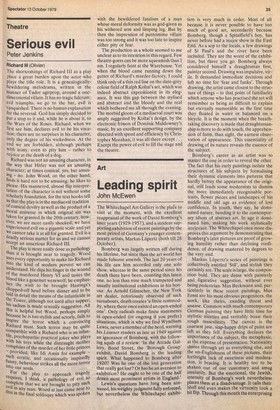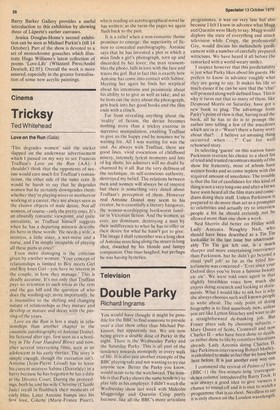Art
Leading spirit
John McEwen
The Whitechapel Art Gallery is the place to visit at the moment, with the excellent reappraisal of the work of David Bomberg's later years (1929-1957), and a strident supporting exhibition of recent paintings by the most prized of Germany's younger contemporary artists, Markus Liipertz (both till 28 October).
Bomberg was largely written off during his lifetime, but since then the art world has made fulsome amends. The last 20 years of his life saw him accorded only one solo show, whereas in the same period since his death there have been, counting this latest one, no less than nine much trumpeted and usually institutional exhibitions in his honour. As Arnold Glimscher, the New York art dealer, notoriously observed of such turnabouts, death creates 'a finite commodity, where there once existed an open-ended one'. Only radicals make finite statements in open-ended (or ongoing if you prefer) situations, which is why we find Wyndham Lewis, never a member of the herd, warning his Listener readers as late as 1949 against an ignorance of Bomberg, with the followIng squib of a review: 'In the Arcade Gal lery, Bond Street, the 'Borough Group' exhibit, David Bomberg is the leading spirit. What happened to Bomberg after 1920? Was he one of the lost generation that really got lost? Or has he an aversion to exhibition? He ought to be one of the half dozen most prominent artists in England.'
Lewis's questions have long been answered, his weighty judgment fully enforced, but nevertheless the Whitechapel exhibi tion is very much in order. Most of all because it is never possible to have too much of good art, secondarily because Bomberg, though a Spitalfield's boy, has never before had a major show in the East End. As a sop to the locals, a few drawings of St Paul's and the river have been included. They are the worst of the exhibition, but there you go. Bomberg always considered himself a draughtsman first, painter second. Drawing was impulsive, virile. It demanded immediate decisions and left no time for 'fear and funks'. Through drawing, the artist came closest to the structure of things — to that point of familiarity which anyone who has practised the art will remember as being as difficult to explain but eternally memorable as the first time they floated in water or balanced on a bicycle. It is the moment when the breathtaking discovery is made that draughtsmanship is more to do with touch, the apprehension of form, than sight, the earnest observation of appearance. This essentiality of drawing,of its nature reveals the essence of the subject.
Bomberg's career as an artist was to master the one in order to reveal the other. The fact that his early paintings isolate the structures of his subjects by formalising their dynamic elements into patterns that hardly betray the appearance of the original, still leads some modernists to dismiss the more immediately recognisable portraits, flower pieces and landscapes of his middle and old age as evidence of lost confidence. In youth, they say, he dominated nature, bending it to the contemporary idiom of abstract art. In age it dominated him, making his work stylistically irrelevant. The Whitechapel once more disproves this argument by demonstrating that Bomberg's later pictures are proof of growing humility rather than declining confidence, of drawing mastered by degrees to the very end.
Markus Liipertz's series of paintings is collectively entitled 'Stir, and stylish they certainly are. The scale is large, the composition bold. They are dense with painterly and figurative suggestion, without ever being pedestrian. Max Beckmann and, particularly in these recent paintings, Max Ernst are his most obvious progenitors, the work, like theirs, exuding threat and unease. Common with much contemporary German painting they have little time for stylistic niceties and veritably boast their rough masculinity. The canvas is the coarsest jute, slap-happy drips of paint are left as they fell. Everything declares the importance of the subject, the metaphysic, at the expense of presentation. Nationality shines through art as everything else, and the un-Englishness of these pictures, their forthright lack of sweetness and moderation, is bracing. It is healthy too to be shaken out of our customary and smug insularity. But the emotional, the Jewish, intensity of Bomberg's work nevertheless places them at a disadvantage. It calls their bluff and even makes the virtuosity look a bit flip. Through this month the enterprising Barry Barker Gallery provides a useful introduction to this exhibition by showing three of Liipertz's earlier canvases, Jessica Douglas-Home's second exhibition can be seen at Michael Parkin's (till 14 October). Part of the show is devoted to a set of monochrome gouaches which illustrate Hugo Williams's latest collection of poems 'Love-Life' (Whizzard Press/Andre Deutsch, f2.95). Overall the work is more assured, especially in the greater formalisation of some new acrylic paintings.



































 Previous page
Previous page